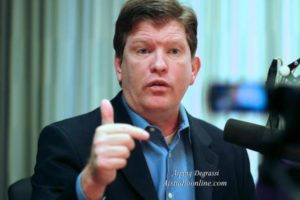By Consumer Watchdog, Special for USDR
Public interest group Consumer Watchdog today reported that twenty-six energy companies including the state’s three major investor-owned utilities, Occidental, Chevron, and NRG—all with business before the state—donated $9.8 million to Jerry Brown’s campaigns, causes, and initiatives, and to the California Democratic Party since he ran for Governor. Donations were often made within days or weeks of winning favors. The three major investor-owned utilities alone contributed nearly $6 million.
An exhaustive review of campaign records, publicly-released emails and other documents at PUCPapers.org, court filings, and media reports, shows that Brown personally intervened in regulatory decisions favoring the energy industry, and points to Brown and his operatives having used the Democratic Party as a political slush fund to receive contributions from unpopular energy companies in amounts greater than permitted to his candidate committee. Between 2011 and 2014, the energy companies tracked by Brown’s Dirty Hands donated $4.4 million to the Democratic Party, and the Democratic Party gave $4.7 million to Brown’s re-election. Earmarking to the Democratic Party is illegal. Consumer Watchdog is forwarding its report to the Fair Political Practices Commission.
“The timing of energy industry donations around important legislation and key pro-industry amendments, as well as key regulatory decisions in which Brown personally intervened, raises troubling questions about whether quid pro quos are routine for this administration,” said consumer advocate Liza Tucker, author of the report, Brown’s Dirty Hands. “While Brown paints himself as a foe of fossil fuels, his Administration promoted reckless oil drilling, burning dirty natural gas to make electricity, and used old hands from industry and government, placed in key regulatory positions, to protect the fossil fuel-reliant energy industry.”
Download Brown’s Dirty Hands at www.consumerwatchdog.org/dirtyhands
View a video on the report here: https://www.youtube.com/watch?v=3t0ZgT-ahLg
Evidence strongly suggests that the timing of certain donations may have elicited or rewarded legislative or regulatory action on behalf of these companies. Among the most egregious examples detailed in the report:
- Southern California Edison donated $130,000 to the California Democratic Party, its largest contribution up until that time, on the same day PUC President Michael Peevey cut a secret deal with an SCE executive in Warsaw, Poland to make ratepayers cover 70 percent of the $4.7 billion cost to close the fatally flawed San Onofre nuclear plant. Brown backed the dirty deal, telling Edison’s CEO personally, according to an email from the CEO uncovered by the Public Records Act, that he was willing to tell the media on the day of the plant’s shuttering that the company was acting responsibly and focused on the right things. Three days prior to SCE’s announcement that it would close San Onofre permanently, the company donated $25,000 to the California Democratic Party.
- Emails from PG&E’s top lobbyist Brian Cherry to his boss claim that Brown personally intervened with a PUC Commissioner to persuade him to approve a natural gas-fired power plant called Oakley for the utility. In a January 1, 2013email, Cherry described a New Year’s Eve dinner with Peevey where Peevey reminded him “how he and Governor Brown used every ounce of persuasion to get [Commissioner Mark] Ferron to change his mind and vote for Oakley…Jerry’s direct plea was decisive.” PG&E donated $20,000 to the California Democratic Party the day after the PUC voted for the project. An appeals court would later strike down the decision because PG&E had not proved its necessity.
- While PG&E’s lobbyist and then-PUC President Michael Peevey fed names to Brown’s executive secretary, former PG&E vice president Nancy McFadden, to appoint the critical swing-vote PUC commissioner who would cast pro-utility votes, PG&E donated $75,000 to the California Democratic Party. The same day that Brown appointed ex-banker Mark Ferron to the commission, PG&E donated another $41,500. The appointment lifted the value of PG&E’s stock and the PG&E stock held by McFadden and valued as high as $1 million.
- Chevron donated $135,000 to the California Democratic Party the same day lawmakers exempted a common method of well stimulation from legislation meant to regulate fracking. After the bill passed with an amendment dropping a moratorium on fracking permits, Occidental gave $100,000 to one of Brown’s favorite causes, the Oakland Military Institute. Brown signed the weakened bill. On December 23, 2013, Chevron donated $350,000 to the Democratic Party. OnDecember 30, the Democratic Party donated $300,000 to Brown for Governor 2014, while Chevron donated the maximum to Brown’s campaign, $54,400, on the same day. Less than two months later, Brown came out publicly to oppose a proposed oil severance tax. The weakened fracking bill also helped Nancy McFadden who held up to $100,000 in Linn Energy that would acquire Berry Petroleum and its 3,000 California fracking wells.
- Occidental’s attorney, former Governor Gray Davis, successfully pressured Brown to fire two oil and gas regulators who wouldn’t grant oil waste injection permits without proof that aquifers would not be contaminated. Two months later, when Brown’s new interim oil and gas supervisor granted Occidental a permit without an environmental review, Occidental contributed $250,000 to Prop 30, Brown’s ballot measure to raise taxes, then another $100,000 two weeks later to his favored Oakland Military Institute. Seven months later, Occidental made a second $250,000 donation to Prop 30.
- Brown’s climate change bill, SB 350, gave utilities a monopoly on electric vehicle infrastructure and large-scale renewable energy projects by excluding rooftop solar from the state’s renewable portfolio standard. Three weeks after a last-minute amendment granting utilities access to a regional grid, PG&E donated $80,000 to the Democratic Party. The utility donated another $50,000 three weeks after the bill was chaptered. Utility stocks increased by at least 14 percent within two months.
- Power plant developer NRG wasn’t a Brown donor until the company cut a sweetheart deal with the PUC to settle the state’s case over its 2001 electricity price manipulation, touted as a win by the Governor’s office. Rather than paying back the state, the company was allowed to spend $100 million of its $120 million fine to build electric vehicle charging infrastructure. Two months later, NRG began donations to Brown, his causes, and his party that would come to $105,000. A lawsuit against the PUC, filed by electric charging station competitor Ecotality, called the deal illegal because it awarded a monopoly to an out-of-state company.
- Lawmakers sent Brown a package of six PUC reform bills in 2015 which would have increased oversight, transparency and accountability at the PUC, and received unanimous, bipartisan support. Brown vetoed the reform bills on October 12, 2015. One week later, PG&E donated $50,000 to the Democratic Party. In December, PG&E donated another $175,000 to the Party.
Brown’s top staffers—Executive Secretary Nancy McFadden and former Cabinet Secretary Dana Williamson—both former PG&E executives, were paid roughly $100,000 each by the California Democratic Party for consulting and fundraising services at various times between 2013 and 2016.
Jerry Brown’s family and other personal ties to industry insiders also appear to play a role in his Administration’s decisions to promote the interests of the utilities and the oil and gas industry at the expense of consumers.
Brown’s sister, Kathleen, was given a seat on Sempra’s board of directors in June 2013, just as lawmakers amended fracking legislation to drop a moratorium on fracking permits. As of April 2016, Kathleen Brown had earned $691,300 for her board service at Sempra, parent company of Southern California Gas which is responsible for the massive Aliso Canyon natural gas well blowout that caused the biggest methane leak in U.S. history. Governor Brown issued an emergency order that ensured secrecy around the blowout investigation, has waged a campaign through his energy regulators to keep Aliso open and has kept information and data involving the blowout secret from the public. Sempra stock has increased by 116% since Brown took office, more than any other utility.
Kathleen Brown also served on the board of real estate and oil company Forestar Group—which owns 700 acres next to Porter Ranch, a community drastically affected by the leak, where Forestar plans to build luxury homes, and another 1,000 acres of oil and gas interests in California. Kathleen holds $749,000 worth of Forestar stock. She now sits on the board of Renew Financial, a private funder of renewable energy projects that stands to benefit from SB 350. She stepped down from Forestar one month after Jerry Brown declared a state of emergency at Aliso Canyon.
Governor Brown supported, appointed and hired a group of old hands from previous administrations and the energy industry that have played a role in policies promoting the fossil-fuel natural gas system. Brown’s Dirty Hands details how the revolving door of industry insiders, including former PUC President Michael Peevey, now under criminal investigation for corruption at the PUC, was supported and installed by Brown and his top aides. The report details crucial moments for the energy industry contributors through the Administration’s course and how Brown sided with them.
The report is released just as ratepayers dodged a bullet in the last month of the legislative session in Sacramento, where the legislature stalled for the year efforts by Brown and his hands to enact a Western regional grid and federalize energy regulation in <spanclass=”xn-location”>California.
SOURCE Consumer Watchdog




